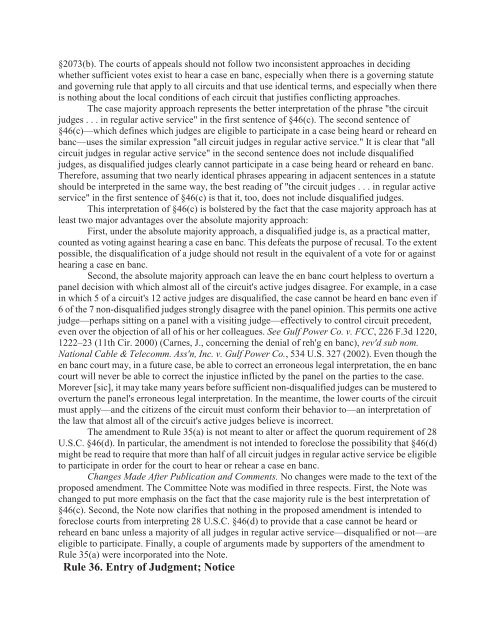Federal Rules of Appellate Procedure 2014-2015, 2014a
Federal Rules of Appellate Procedure 2014-2015, 2014a
Federal Rules of Appellate Procedure 2014-2015, 2014a
You also want an ePaper? Increase the reach of your titles
YUMPU automatically turns print PDFs into web optimized ePapers that Google loves.
§2073(b). The courts <strong>of</strong> appeals should not follow two inconsistent approaches in deciding<br />
whether sufficient votes exist to hear a case en banc, especially when there is a governing statute<br />
and governing rule that apply to all circuits and that use identical terms, and especially when there<br />
is nothing about the local conditions <strong>of</strong> each circuit that justifies conflicting approaches.<br />
The case majority approach represents the better interpretation <strong>of</strong> the phrase "the circuit<br />
judges . . . in regular active service" in the first sentence <strong>of</strong> §46(c). The second sentence <strong>of</strong><br />
§46(c)—which defines which judges are eligible to participate in a case being heard or reheard en<br />
banc—uses the similar expression "all circuit judges in regular active service." It is clear that "all<br />
circuit judges in regular active service" in the second sentence does not include disqualified<br />
judges, as disqualified judges clearly cannot participate in a case being heard or reheard en banc.<br />
Therefore, assuming that two nearly identical phrases appearing in adjacent sentences in a statute<br />
should be interpreted in the same way, the best reading <strong>of</strong> "the circuit judges . . . in regular active<br />
service" in the first sentence <strong>of</strong> §46(c) is that it, too, does not include disqualified judges.<br />
This interpretation <strong>of</strong> §46(c) is bolstered by the fact that the case majority approach has at<br />
least two major advantages over the absolute majority approach:<br />
First, under the absolute majority approach, a disqualified judge is, as a practical matter,<br />
counted as voting against hearing a case en banc. This defeats the purpose <strong>of</strong> recusal. To the extent<br />
possible, the disqualification <strong>of</strong> a judge should not result in the equivalent <strong>of</strong> a vote for or against<br />
hearing a case en banc.<br />
Second, the absolute majority approach can leave the en banc court helpless to overturn a<br />
panel decision with which almost all <strong>of</strong> the circuit's active judges disagree. For example, in a case<br />
in which 5 <strong>of</strong> a circuit's 12 active judges are disqualified, the case cannot be heard en banc even if<br />
6 <strong>of</strong> the 7 non-disqualified judges strongly disagree with the panel opinion. This permits one active<br />
judge—perhaps sitting on a panel with a visiting judge—effectively to control circuit precedent,<br />
even over the objection <strong>of</strong> all <strong>of</strong> his or her colleagues. See Gulf Power Co. v. FCC, 226 F.3d 1220,<br />
1222–23 (11th Cir. 2000) (Carnes, J., concerning the denial <strong>of</strong> reh'g en banc), rev'd sub nom.<br />
National Cable & Telecomm. Ass'n, Inc. v. Gulf Power Co., 534 U.S. 327 (2002). Even though the<br />
en banc court may, in a future case, be able to correct an erroneous legal interpretation, the en banc<br />
court will never be able to correct the injustice inflicted by the panel on the parties to the case.<br />
Morever [sic], it may take many years before sufficient non-disqualified judges can be mustered to<br />
overturn the panel's erroneous legal interpretation. In the meantime, the lower courts <strong>of</strong> the circuit<br />
must apply—and the citizens <strong>of</strong> the circuit must conform their behavior to—an interpretation <strong>of</strong><br />
the law that almost all <strong>of</strong> the circuit's active judges believe is incorrect.<br />
The amendment to Rule 35(a) is not meant to alter or affect the quorum requirement <strong>of</strong> 28<br />
U.S.C. §46(d). In particular, the amendment is not intended to foreclose the possibility that §46(d)<br />
might be read to require that more than half <strong>of</strong> all circuit judges in regular active service be eligible<br />
to participate in order for the court to hear or rehear a case en banc.<br />
Changes Made After Publication and Comments. No changes were made to the text <strong>of</strong> the<br />
proposed amendment. The Committee Note was modified in three respects. First, the Note was<br />
changed to put more emphasis on the fact that the case majority rule is the best interpretation <strong>of</strong><br />
§46(c). Second, the Note now clarifies that nothing in the proposed amendment is intended to<br />
foreclose courts from interpreting 28 U.S.C. §46(d) to provide that a case cannot be heard or<br />
reheard en banc unless a majority <strong>of</strong> all judges in regular active service—disqualified or not—are<br />
eligible to participate. Finally, a couple <strong>of</strong> arguments made by supporters <strong>of</strong> the amendment to<br />
Rule 35(a) were incorporated into the Note.<br />
Rule 36. Entry <strong>of</strong> Judgment; Notice


















